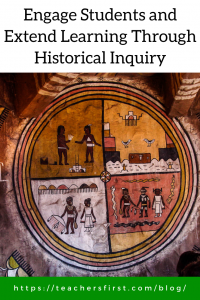“You don’t hate history, you hate the way it was taught to you in high school.”
Stephen Ambrose, American historian 1936-2002
What do you remember from your history classes? How much time did you spend reading textbooks and watching films? Do you remember having an opportunity to come up with your own questions and research the answers?
For many adults, history class was dry and dull. This scene from Ferris Bueller’s Day Off is a classic because it is relatable to many of us. “Anyone?!”
In 2016, Ruth Okoye wrote a blog post about active learning that remains relevant to our discussion of engaging students through collaboration, discussions, and real-world problem-solving – all of which are components of historical inquiry. Historical inquiry moves students from being passive participants in history instruction to becoming involved in the doing of history. By posing questions, collecting and analyzing evidence, and engaging in discussions of significant issues, students better understand the past and develop individual understandings of history.
Learn more about historical inquiry at HistoricalInquiry.com or by watching this video explanation. This site explains the concept and shares a guided look at the phases used to teach students how to interpret and understand primary sources and reconcile differing historical accounts of events. Other benefits are:
- By allowing students to ask questions and explore different points of view, they are more likely to see and understand information in ways that develop culturally competent historical viewpoints. Students bring their unique backgrounds and questions to help them understand history through various lenses rather than just reading it as a story in a textbook.
- Historical inquiry is very student-centered. Instead of spoon-feeding facts and information, this teaching method engages students and asks them to analyze, understand, and develop their interpretations of information by locating and analyzing primary sources and evidence.
- Students become more engaged in their learning because they make choices based on what they want to learn. Of course, educators guide this learning within their curriculum. The benefit is students leave with a deeper understanding of history instead of just an overview of facts and dates.
- Historical inquiry fits well within many teaching and technology frameworks. Think about backward design and project-based learning models that encourage learning through real-world and personally meaningful projects. If using technology, think about the TripleE Framework – the final E is an extension where students connect their learning to the real world.
Let’s visit Reading Like a Historian (reviewed here) for some ideas to see how inquiry might work in your classroom. Thomas Jefferson’s birthday is this month (April 13), so let’s use him and his role in the American Revolution as a starting point.
- Hamilton vs. Jefferson – This lesson uses an excerpt from a textbook along with copies of letters Jefferson and Hamilton sent to Washington for students to compare and contrast. Student materials include guided questions for exploration and ask students to use evidence to support their conclusion on who started the “fight” between the two men.
- Louis XVI – What did Thomas Jefferson have to do with Louis XVI? In this lesson, students analyze an excerpt from Jefferson’s memoir to understand the strengths and weaknesses of primary sources.
Reading Like a Historian provides other valuable materials for use in inquiry classrooms.
- Classroom resources – Find classroom posters, lessons on evaluating sources, and introductory lessons about the concept of historical thinking. One valuable resource is the Historical Thinking Chart that is available in English and Spanish. Save this chart to find questions and prompts to guide students through skills such as sourcing, providing context, and corroboration of evidence.
- Beyond the Bubble Assessments – Choose by topic or use filters to narrow options based on the historical skills (use of evidence, background knowledge, etc.). Flagship assessments include extended features such as sample responses and a video on how to use the assessments. Although none of the flagship assessments relate to the American Revolution, their extended features provide ideas for using historical inquiry methods in your classroom.
As students become immersed in inquiry projects, take advantage of technology to further extend learning with these tech tools:
- Adobe Spark for Education (reviewed here) – Create posters and flyers that represent and share information about events and individuals or ask students to make memes that emphasize an event or character. Take a look at this one for Thomas Jefferson.
- ClassTools timeline creator (reviewed here) – Create timelines from Wikipedia for Thomas Jefferson and Alexander Hamilton. Ask students to compare and contrast events found on the timelines as a way of understanding how they developed their points of view.
These templates allow students to share understanding through creative methods. Most are view-only files, but you can make a copy for your use, by clicking file> make a copy> and saving it to your Google drive:
- Time Magazine template, courtesy of @creativeedtech
- Historical GoFundMe Template, adapted by @hcmurdoch
- Twitter template of a historical figure, courtesy of @historyfrog
- Instagram Template, courtesy of @TeachingTechNix
- Group Document-Based Question template, courtesy of @MrsByarsHistory
Find all of these templates and resources in this Wakelet collection, along with a few bonus items. Copy the collection or save it to your bookmarks to use as a starting point and add additional resources for your teaching needs.
What does your history class look like? Are you doing all that you can to engage learners and offer different perspectives? Consider the benefits of teaching through historical inquiry methods as a way to bring life to your lessons and engage all learners. We love to hear from our readers – share your thoughts and tips in the comments below!


